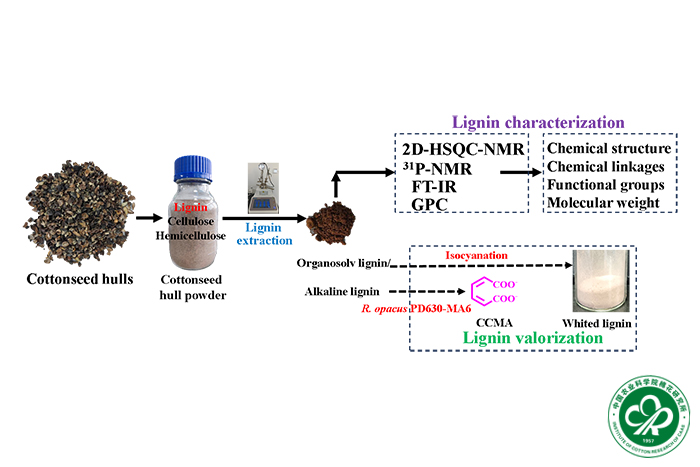- Location : Home» Newsroom
Characterization of cottonseed hull lignin for valorizing it into value-added chemicals and materials
Recently, a researcher at the Cotton Research Institute of the Chinese Academy of Agricultural Sciences, revealed the chemical composition of cottonseed hull and the basic characteristics of cottonseed hull lignin, and used chemical and biological conversion methods to convert cottonseed hull into new bio-based materials and chemicals, providing a reference for the high-value utilization of cottonseed hull. The relevant research results were published in the internationally renowned journal " Industrial Crops and Products " (IF=5.6) under the title " Characterization of cottonseed hull lignin for valorizing it into value-added chemicals and materials ".
In this study,Cottonseed hulls (CSHs) emerge as a promising lignocellulosic feedstock for synthesizing high-value products through the biorefinery approach. However, scant attention has been devoted to a detailed characterization of their primary components, particularly the intricate lignin fraction. This study conducted a comprehensive compositional analysis of CSHs, primarily delving into the intricate characterization of lignin samples extracted via organosolv and alkaline methods. The investigation encompassed the fundamental lignin unit composition, inter-chemical linkages, molecular weight distribution, and functional group profile. Further analysis revealed that alkaline-extracted lignin possesses a higher abundance of low-molecular-weight lignin fragments and hydroxyl groups than organosolv-extracted lignin. This distinct characteristic renders alkaline lignin a favorable candidate for producing chemicals and functional materials via bioconversion and chemical modification. To demonstrate this, alkaline lignin was successfully valorized into cis , cis -muconate and white lignin material. This study provides valuable insights into the fundamental characteristics of CSH lignin, uncovering its potential for the synthesis of value-added chemicals and materials.
This work was supported by the National Natural Science Foundation of China (No. 22308374), Fundamental Research Funds for Central Public Welfare Research Institutes (No. 1610162023045), Independent project of State Key Laboratory of Cotton Bio-breeding and Integrated Utilization (No. CBIU2023ZZ01), National Natural Science Foundation of China-Henan Joint Fund (No. U23A20182), China Engineering Science and Technology Development Strategy Henan Research Institute 2023 Strategy (No. 2023HENZDB03), and Central Public-interest Scientific Institution Basal Research Fund (Y2024QC21).
https://doi.org/10.1016/j.indcrop.2024.119666
